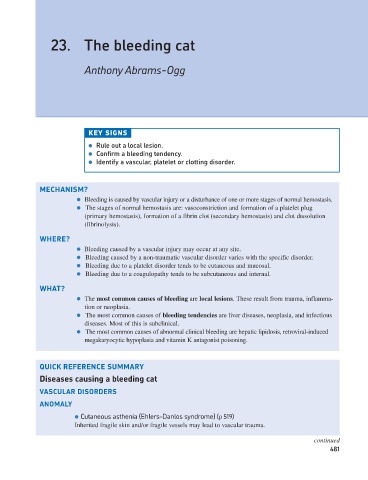Page 489 - Problem-Based Feline Medicine
P. 489
23. The bleeding cat
Anthony Abrams-Ogg
KEY SIGNS
● Rule out a local lesion.
● Confirm a bleeding tendency.
● Identify a vascular, platelet or clotting disorder.
MECHANISM?
● Bleeding is caused by vascular injury or a disturbance of one or more stages of normal hemostasis.
● The stages of normal hemostasis are: vasoconstriction and formation of a platelet plug
(primary hemostasis), formation of a fibrin clot (secondary hemostasis) and clot dissolution
(fibrinolysis).
WHERE?
● Bleeding caused by a vascular injury may occur at any site.
● Bleeding caused by a non-traumatic vascular disorder varies with the specific disorder.
● Bleeding due to a platelet disorder tends to be cutaneous and mucosal.
● Bleeding due to a coagulopathy tends to be subcutaneous and internal.
WHAT?
● The most common causes of bleeding are local lesions. These result from trauma, inflamma-
tion or neoplasia.
● The most common causes of bleeding tendencies are liver diseases, neoplasia, and infectious
diseases. Most of this is subclinical.
● The most common causes of abnormal clinical bleeding are hepatic lipidosis, retroviral-induced
megakaryocytic hypoplasia and vitamin K antagonist poisoning.
QUICK REFERENCE SUMMARY
Diseases causing a bleeding cat
VASCULAR DISORDERS
ANOMALY
● Cutaneous asthenia (Ehlers–Danlos syndrome) (p 519)
Inherited fragile skin and/or fragile vessels may lead to vascular trauma.
continued
481

